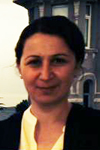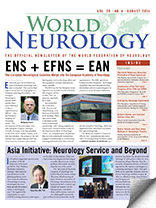
Birgit Surböck
The First Joint Congress of the ENS and EFNS took place in June 2014 in Istanbul.
Peripheral Neuropathies
Rudolf Martini, Würzburg, Germany, was the first speaker of this session and talked about opportunities for treatment of CMT diseases. At the moment, there is no cure for these genetic neuropathies. Studies (mouse and human) with many substances studied, such as ascorbic acid, progesterone antagonist, curcumin, neurotrophin 3, carried out without success. In the German laboratory, mediators for the involvement of phagocytosing macrophages have been detected in the demyelination and perturbation of axons. These mediators are monocyte chemo-attractant protein-1 (MCP-1; Ccl2) and colony-stimulating factor-1 (Csf-1). The idea was that attenuating macrophage-related peripheral nerve inflammation could be a putative option to ameliorate disabling symptoms associated with CMT-1.

Alexander Tinchon
Phase 1 clinical trials with a highly selective Csf-1-receptor inhibitor were promising. Another approach injected human adipose-derived mesenchymal stem cells (MSCs) isolated from lipo aspirate into tail veins of Cx32-deficient mice, a model for CMT-1X. Single injection of these immune modulatory xenografts caused macrophage attenuation and mild preservation of myelin.
Next, Rayaz A. Malik, Manchester, United Kingdom, presented on diabetic neuropathy. The problem in finding the optimal tools for diagnosis and treatment is the design of studies. What should be used for primary endpoint? Clinical status, vibration threshold, electrophysiological findings?

Leyla Alpaslan
Often, there is only an evaluation of the Aβ-fibers and not C-fibers, which are responsible for pain, skin blood flow, inflammation and ulceration. An alternative diagnosis tool to skin biopsy could be corneal confocal microscopy, as there are more than 7,000 nociceptors per mm2 in the cornea. In studies, the loss of corneal C-fibers was in concordance with the progression of the neuropathy. Malik concluded with the statement: “Look into my eyes and predict my risk of amputation.”
Pieter A. van Doorn, Rotterdam, discussed how to optimize treatment in immune-mediated neuropathies. About one-fourth of patients with GBS develops respiratory insufficiency, and many have signs of autonomic dysfunction and pain. Prognostic models can help to predict the chance that an individual patient will require artificial ventilation, and to predict the probability to walk unaided after half a year. EGRIS score and mEGOS are tools that can be used early in the course of disease.

Sabrine Pollanz
Treatment is well known with intravenous immunoglobulin (IVIg) or plasma exchange. Important to consider that about 10 percent of GBS patients will have a treatment-related deterioration (TRF), requiring a repeated treatment course. Other patients initially diagnosed as GBS will turn out to have acute-onset chronic inflammatory demyelinating polyradiculoneuropathy (A-CIDP). Treatment of CIDP include steroids, IVIG and plasma exchange. Most patients need intermittent maintenance treatment.
The session ended with an overview of treatment in amyloid neuropathy (AN) from David Adams, Kremlin-Bicàªtre, France. As AN is a systemic disease, patients should be screened for cardiologic, renal and ocular manifestations in transthyretin FAP (TTR-FAP) or hematologic involvement for light-chain amyloidosis (AL-amyloidosis).

Anna Grisold
To remove the main source of variant TTR, liver transplantation is performed depending on the stage of the neuropathy, the variant TTR, the age of the patient and severity of organ involvement. Liver transplantation, which has been performed since 1991, has better results in early onset. Pacemaker implantation should be discussed in case of significant conduction disorder. Heart or kidney transplantation must be discussed in end-stage cardiac or renal failure in Stage 1 neuropathy.
For light chain amyloidosis, chemotherapy, in combination with high dose dexamethasone, is used to control the underlying plasma clone that produces amyloidogenic light chain. Another option is the application of monoclonal antibodies against human serum amyloid P component. At the moment, a Phase 1 study is ongoing in the U.K.
Chemotherapy-Induced Neuropathies
Prof. Cavaletti, Italy, talked about chemotherapy-induced neuropathies (CIPN), which present an increasingly clinically relevant issue. Due to improvement and extension of chemotherapies, the overall survival rate of tumor patients is rising, though the number of the exact incidence is lacking.
However, neurotoxic drugs with substances such as platin derivates, taxanes, vinca-alcaloids, bortezomib and thalidomide are becoming a major dose-limiting factor. The epidemiology is still unclear.
CIPN are dose-dependent and occur after a cumulative dose, mostly after three to four cycles.
CIPN are predominantly sensory with dysaesthesia, paraesthesia, burning sensations, pain, ataxia and gait disorders. Motoric or autonomic, as well as, cranial nerve involvement is rare. Oxaliplatin should be highlighted, as it induces acute transient side effects as coldness-associated pain, and muscle cramps especially in the jaw and bulbar distribution.
An important issue is “coasting.” Patients treated with platinum derivates may develop worsening neuropathic symptoms after treatment has ceased.
For the clinical involvement and evaluation of CIPN, questionnaires are used, such as the Total Neuropathy Score (TNS) or the National Institute Cancer Toxicity Scale (NCI-CTC). The sensitivity is limited due to interindividual reliability.
Measurement of sensory and motor nerve conduction velocity (NCV), sensory nerve action potential (SNAP) and compound muscle action (CMAP) together with electromyography (EMG) are standard neurophysiological tests used. Diminished amplitude of SNAP in NCV is thought to reflect axonal loss from sensory nerves. In case of inconclusive results, a skin/nerve biopsy may be considered.
Pre-existing neuropathies, due to diabetes, alcohol abuse or hereditary neuropathies as well as concomitant chemotherapies may facilitate or worsen CIPN. However, the correlation remains unclear.
Neuroprotectives are still lacking. Several substances have been tried but without success. Symptomatic treatment targeted with either neuropathic pain therapy or physical therapy and rehabilitative measures must always be considered.
In summary, CIPN present a serious adverse effect due to limitation in quality of life. Studies with the evaluation of biomarkers to identify patients with the high risk of developing CIPN are needed. Data of long-time effects are lacking. Further studies are needed to achieve a standardized treatment of CIPN and its complication.
Movement Disorders
Oral sessions and teaching courses were provided throughout the congress, spanning all relevant topics from idiopathic Parkinson’s disease to hyperkinetic movement disorders. The first two days were dedicated to Parkinson syndromes in general and organized as oral sessions focused on novel diagnostic and therapeutic strategies. The first session included an interesting prospective cohort study, which explained the potential meaning of a particular olfactory assessment in early diagnosis of Parkinson’s disease in patients with rapid eye movement sleep behavior disorders.
The use of apomorphine was highlighted as good therapeutic option in patients with morning akinesia and reviewed as a reasonable drug for improved quality of life in a multicenter prospective French trial.
Atypical Parkinson syndromes were discussed in a separate session, underlining autonomic disorders as a leading symptom in the diagnosis of MSA. An extrapyramidal syndrome with rapid progression, poor response to L-Dopa and other uncommon symptoms such as early dementia, apraxia or stridor should be considered as an atypical Parkinson’s syndrome. Stridor in particular seems to be an underestimated symptom in this differential diagnosis. On the other hand, fragile-X-associated tremor-ataxia-syndrome was introduced as a rare but possible differential diagnosis in patients with atypical Parkinson syndromes.
The therapeutic approaches on MSA are still limited, since rasagiline, lithium and fluoxetine failed to prove a significant benefit. Although accompanied by a poor prognosis, MSA should be considered as a heterogeneous disease with a challenging effort in diagnostic and therapeutic efforts.
A highlight of this year´s congress was the interactive sessions in which patient videos were presented, and the audience could vote among several differential diagnoses. In the session “paroxysmal events” intermittent movement disorders, as the paroxysmal kinesigenic dyskinesias (PKD) with sudden attacks of involuntary movements, including dystonia, chorea, athetosis or ballism, precipitated by sudden movements were shown. Also presented, patients with paroxysmal non-kinesigenic dyskinesias (PNKD), that usually occur spontaneously or may be triggered by consumption of alcohol or caffeine, and the paroxysmal exercise-induced dyskinesia (PED).
Examples of faciobrachial dystonic seizures, nocturnal frontal lobe epilepsy and L-Dopa-induced dystonic-ballistic dyskinesias in Parkinson’s disease demonstrated the difficult differentiation against psychogenic movement disorders.
Improving Outcomes of CNS Infections and Autoimmune Encephalitis
Diederik van de Beek, Amsterdam, presented the first session about bacterial meningitis. He presented the dilemmas in the diagnosis of acute community-acquired bacterial meningitis and focused on strategies to optimize antibiotic efficacy in view of increasingly drug-resistant bacteria. He also discussed the role of current and future adjunctive therapies. Clinical data to support new antibiotics in the treatment of multidrug-resistant bacteria are scarce.
Whether adjunctive anti-inflammatory therapies (e.g. dexamethasone) improve outcomes in patients with bacterial meningitis remains controversial and are being tested further. In the European clinical trial from 301 adults with meningitis who started dexamethasone 40 mg/d for four days before/with first dose antibiotics, it decreases mortality and hearing loss. Another adjunctive therapy, hypothermia, tested by a randomized open-label, blind endpoint trial has no beneficial effect. Rapid diagnosis and treatment reduces mortality, therefore it should be started simultaneously with an adjunctive therapy.
Johann Sellner, Austria, then talked about strategies to improve the outcome of viral encephalitis. Early suspicion and diagnosis are crucial. A delay of more than two days between admission to the hospital and antiviral treatment has a poor outcome. The clinical spectrum of presentation is broad and leads to misdiagnosis such as altered mental status, sepsis and seizures. Herpes simplex virus (HSV) and varicella zoster virus (VZV) are most commonly involved in sporadic disease, while in about one third of the patients the agent cannot be identified despite extensive diagnostic efforts.
The correct dosage of acyclovir is given in 75 percent of cases and should be IV 10 mg/kg every eight hour for a period of 14-21 days. In cases of negative PCR and no alternative diagnosis by suspected HSE, the duration of therapy is for 10 days.
M. Titulaer, Barcelona, Spain, then discussed autoimmune encephalitis . He mainly focused on anti-NMDA receptor encephalitis, the clinical picture, treatment and outcome. Clinical symptoms, abnormal CSF with lymphocytic pleocytosis, raised total protein and oligoclonal bands; abnormal EEG and MRI are essential for the diagnosis. After a prodromal phase, the clinical deterioration starts with symptoms of agitation, psychosis, catatonia, memory deficit, speech reduction, abnormal movements and seizures to coma, hypoventilation and dysautonomia.
Other types of encephalitis as LGI1-encephalitis and its clinical symptoms such limbic encephalitis, memory loss, myoclonic-like movements, hyponatremia, seizures and its outcome were presented and discussed.
Uncommon Causes of Dementia
Philip Scheltens, Amsterdam, opened with comments about prevention for Alzheimer’s disease. It is a challenge not only for neurologists but also for all health care systems in Europe because dementia will become the most significant brain disorder in the next 30 years.
Obesity and smoking increase the risk of developing dementia, while physical activity and moderate alcohol consumption decrease the risk. Consequent blood pressure treatment is successful in prevention whereas statins and vitamin B12 substitution showed no effect. A current ongoing trial is the pre-DIVA (Prevention of Dementia by Intensive Vascular Care) study with 15,000 person years. It will be completed in 2015.
Protective genes are identified – for example, APOE 2 and APP mutation A673T.
Antiamyloid strategies with immunotherapies (bapineuzumab, gantanerumab), anti tau therapies, neuroprotection and dietary interventions are subjects of studies and are expected soon.
Jonathan Schotts, London, presented on the connection between dementia and immune mediated syndromes. Whereas patients with degenerative dementia are older and show slow progression with “little neurology” as well as atrophy in MRI-scans, autoimmune dementias occur in young/middle-aged patients with sub-acute onset. Symptoms include confusion and delirium. Progression is rapid and MRI shows signal changes. Classical antibodies are anti Hu, Ma1+2, amphiphysin, in the last 10 years, antibodies directed against the voltage-gated potassium channel complex have been detected, which can produce a sub-acute and potentially treatable limbic encephalopathy usually in the absence of an underlying tumor.
Subsequent studies have defined specific antigenic targets (LGI1, CASPR2 and contactin-2) within the potassium channel complex. Facio brachial dystonic seizures precede the development of cognitive decline and are immunotherapy responsive. As a consequence, the treatment may prevent cognitive impairment. Other rare antibody-mediated encephalopathies, including those associated with antibodies directed against NMDA, AMPAR, GABA-B, GAD and Glycine receptors, are now recognized.
Sandro Sorbi, Florence, talked about causes for rare dementias. An overlap between uncommon dementias and young-onset dementia can be derived from the epidemiological data. This could be young-onset forms of common neurodegenerative dementias such as familiar Alzheimer’s disease, dementia associated with other neurological disorders (Huntington’s disease, myotonic dystrophies, autosomal dominant cerebellar ataxia or hereditary spastic paraparesis) or late-onset forms of childhood conditions, such as mitochondrial disorders, lysosomal storage disorders and leukodystrophies. Inflammatory disorders and infectious or toxic-metabolic abnormalities also can be the causes of rare dementia. Clinical data are not sufficient. Most of them are based on single case reports.
Murat Emre from the host city Istanbul, closed out the congress talking about Parkinsonism associated with cognitive impairment. Two forms can be discriminated dementia with Lewy Bodies (DLB) and dementia associated with Parkinson’s disease (PD-D). There also are mixed forms such as “Lewy-body variant of Alzheimer’s disease.” In both biochemically a cholinergic deficit exists, which can be demonstrated in autopsy and PET studies. For this reason, cholinesterase inhibitors have been shown to provide some benefits in both conditions. Clinically, patients show decreased performance in executive functions, visual spatial functions and present with hallucinations. There are more similarities than differences in these two syndromes.
Surböck is from the Department of Neurology, Kaiser Franz Josef Hospital, Vienna, Austria. Tinchon is from the Department of Neurology, Kaiser Franz Josef Hospital, Vienna, Austria. Alpaslan is from the Department of Neurology, Kaiser Franz Josef Hospital, Vienna, Austria. Pollanz is from the Department of Neurology, Kaiser Franz Josef Hospital, Vienna, Austria. Grisold is from the University Clinic of Neurology, AKH Vienna, Austria.
